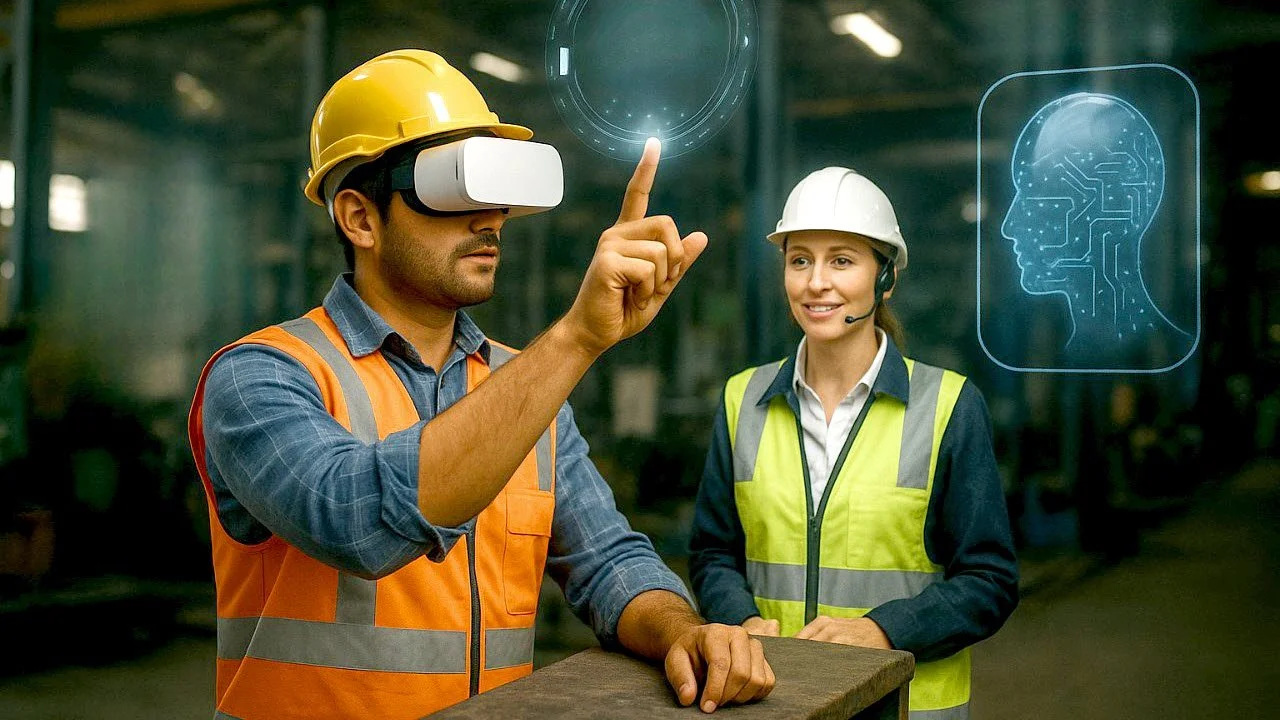AI Safety Training: VR, Wearables & Real-Time Learning
The Shift Begins
Traditional safety training is falling short, and workers are paying the price. Discover how AI is reshaping workplace safety through immersive VR, real-time wearables, and multilingual tools that make training personal, inclusive, and unforgettable. This article examines the transition from compliance to culture and how your business can take the lead.
In her first week at IronCore Industries, Amira still didn’t know which door led to the breakroom and which one to avoid entirely (hint: the one marked “Arc Flash Zone”). She had just endured the mandatory “Safety Orientation Slideshow”—a digital relic that felt more like punishment than protection. “It was like being read bedtime horror stories, in a language I barely knew,” she said.
Then came the close call. A small misread signal on the floor nearly led her into a restricted zone, saved only by a colleague’s whistle. “The training didn’t stick,” she admitted later. “I remembered slide numbers more than the actual protocols.” Her story echoes a troubling truth: the training meant to protect workers often leaves them exposed.
How AI Is Revolutionizing Safety Training
Immersive Environments That Build Real Muscle Memory
VR and AR bring training out of the classroom and onto the shop floor—virtually.
Imagine learning how to stop a conveyor malfunction, escape a fire, or manage a forklift failure—not through a binder, but inside a simulated environment that mimics real-life pressure. Virtual and augmented reality (VR/AR) technologies, powered by AI, enable workers to train in high-risk scenarios without risk. One worker, Greg, a 52-year-old crane operator, used VR to practice emergency stops and hazard avoidance. A week later, he identified a real equipment failure before it escalated. VR and AR don’t just teach—they prepare, embedding safety instincts before real danger strikes.
Breaking the Language Barrier with AI
Multilingual support isn’t just inclusive—it’s mission-critical.
AI-driven platforms now offer instant translation, subtitles, and culturally tuned examples, transforming generic English-only modules into clear, practical lessons for global teams. For Elena, a Ukrainian-speaking welder, having access to instructions in her language transformed her performance and helped her train others. Better yet, tools can detect regional dialects and adjust tone and visuals accordingly. The result? Increased retention, fewer missteps, and stronger engagement from every corner of the team.
Real-Time Feedback with Wearables
Smart gear acts like a personal safety coach—without the micromanagement.
Smart vests, wristbands, and helmet sensors now monitor fatigue, temperature, posture, and proximity to hazards in real-time. These aren’t surveillance tools—they’re lifesavers. During a record heatwave, one IronCore supervisor received a wearable alert about a worker’s overheating. Intervention came just in time to prevent collapse. These tools aren’t replacements for leadership—they’re extensions of it, providing frontline awareness that humans alone can’t always maintain.
Actions Today: Start With These Four Moves
Audit Your Training Program
Look for signs of outdated content, language inconsistencies, and low retention rates. Talk to frontline staff. Are protocols remembered or just signed off?Pilot One High-Risk Task in VR
Select a recurring incident type, such as lockout/tagout errors or equipment handovers, and trial a VR module. Measure changes in engagement and incident rates.Add Multilingual Tools
Use AI-driven translation to update safety documents and modules into the top three languages spoken on your floor. Ensure that voiceovers and subtitles accurately reflect regional nuances.Deploy Wearables in Heat- or Fatigue-Prone Areas
Start small with 10–20 smart vests or wristbands. Monitor alert frequency, response speed, and risk reduction. Use these insights to build broader cases for scale.
Conclusion
From Amira’s near-miss to Greg’s proactive crane shutdown, one thing is clear: workers don't need more slides—they need smarter support. AI brings that support in real-time, in real languages, and with real impact. Companies that invest in immersive, inclusive, and intelligent training are not just preventing injuries; they’re building stronger, more engaged teams. Safety is no longer just about avoiding harm; it's about unlocking human potential with tools that truly meet workers where they are.
Start by asking your team where safety training is falling short. Is it retention? Language? Real-world application? Then take one step—pilot a VR module, try a wearable, or translate a critical training. Don’t wait for an incident to force change. Act now, build trust, and lead with empathy and innovation.
If you'd like to explore tools or pilot programs that fit your team's needs, reach out. Let’s build a safer, more innovative workplace together.
#WorkplaceSafety #AITraining #FutureOfWork #Leadership #VRTraining #ManufacturingSafety #SmartWearables #InclusionAtWork #SafetyCulture #EHS


